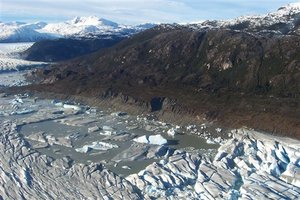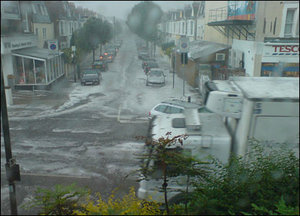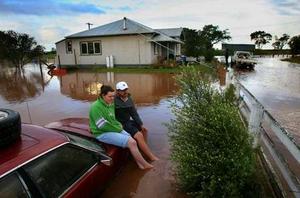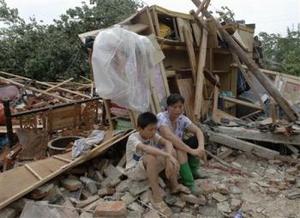
|
| ©AP Photo/HO/Chile Navy
|
| This picture taken from a Chilean navy shows large pieces of ice and some areas with water at the bottom of a lake in southern Chile that was discovered dried up late may.
|
SANTIAGO, Chile - Scientists on Tuesday blamed global warming for the disappearance of a glacial lake in remote southern Chile that faded away in just two months, leaving just a crater behind.
BBCTue, 03 Jul 2007 18:47 UTC
For a brief period this afternoon, parts of South London were deluged by a freak hailstorm. Readers have been sending in pictures.

|
| ©Anthony Beck, Fulham.
|
Two earthquakes shook an area just west of the Monterey Bay early this morning, according to initial reports from the U.S. Geological Survey.
Both earthquakes had epicenters 5 miles southeast of Aromas, around 12 miles west of Hollister, according to the USGS.
The first quake was felt at 1:30 a.m. and measured at a magnitude of 2.2, while the second quake occurred at 4:12 a.m. and had a magnitude of 2.1.
Two other earthquakes occurred in the area Monday afternoon and measured at magnitudes of 3.0 and 4.3.
Arctic ponds that have hosted diverse ecosystems for thousands of years are now disappearing because of global warming, according to a new study.
These ponds, which lie atop bedrock, freeze solid in the winter and then melt for a few months each summer, becoming hot spots of activity in the forbidding Arctic terrain.
Chris Evans, Daniel Ziffer and Paul Heinrichs
The AgeSun, 01 Jul 2007 19:15 UTC
Residents of the four most vulnerable flood-affected areas in Gippsland were last night being urged to evacuate rather than risk being stranded by waters expected to reach 1.6 metres above normal levels.
Authorities were suggesting evacuations as Gippsland entered its fourth day of flooding after the
heaviest rainfalls in almost 40 years.

|
| ©Craig Sillitoe
|
| Not going anywhere: Scott Elliott and partner Ashlee Holmes survey the water surrounding their Newry home.
|
Huge waves crashed against the coast in the district of Kendrapara on Friday, submerging at least two seaside villages and affecting around 200 families. Under the impact of the deep depression formed over northwest Bay of Bengal, huge sea waves inundated two villages under Satbhaya panchayat of Kendrapara district. Ten to 12 feet high waves, churned up by strong winds, marooned Kanhupur and Satbhaya villages damaging several houses including a primary school building, Sasmita Das, Sarpanch of Satbhaya Panchayat, said.
UPISun, 01 Jul 2007 16:58 UTC
New Jersey and Pennsylvania are seeing their worst invasion of damaging Gypsy moth caterpillars in nearly two decades, it was reported Sunday.
The caterpillars have stripped nearly 1.6 million acres in the two states in the last three months, leaving bare an area the size of Delaware, The Philadelphia Inquirer reports.
Construction worker Kevin Forrence was loading up his truck one recent morning, getting ready to start his day at Gate City Fence on Ledge Street, when he noticed an unfamiliar shape on the other side of the canal.
"It was 5 a.m.; the sun wasn't out, but you could see," he said. "I just turned around, and it caught my eye. There was a black bear casually walking down the bike trail."
Forrence, 36, said he yelled out to the bear to try to make it stop, so he could get a better look and maybe capture the animal on his cellphone camera. But it was too dim, and the bear too far away. It stopped for a moment, glanced over at Forrence, and continued walking away. Later, other people reported seeing it poking into a D umpster near a Dunkin' Donuts.
"I've never seen a bear in the wild," said Forrence, who spends considerable time hiking and camping in the White Mountains. "All of a sudden, I'm in the center of Nashua, and there's a bear walking down the trail. Nashua is the last place I'd ever thought to see it."
Researchers at the University of Utah and elsewhere have developed a new way to predict when vegetation dries to the point it is most vulnerable to large-scale fires in the Santa Monica Mountains near Los Angeles. And this year's forecast says the highest-risk fire period will begin July 13 - weeks earlier than usual.
Despite that, the new study also shows that unlike other areas of the western United States, global warming has not caused any apparent long-term trend toward early fire seasons in the Santa Monicas.
The scientists eventually hope to expand their unique fire-risk forecasting method to all of Southern California and beyond.
"We developed a way to predict when the time of highest fire danger begins in the Santa Monica Mountains, based on the amount of spring precipitation," says the study's principal author, Philip Dennison, an assistant professor of geography at the University of Utah. "We estimate that this year, the highest fire danger will begin July 13."
The study found the amount of March-April-May precipitation can be used to predict the date at which high fire-risk thresholds are reached.


